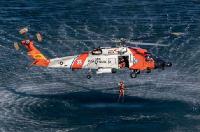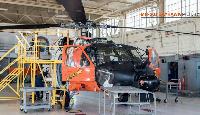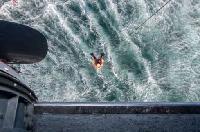Фотографии
-
A Coast Guard rescue swimmer prepares for a freefall insertion into the water.
Самолёты на фотографии: Sikorsky UH-60 Black Hawk / S-70 - США - 1974
-
The aircrew practice a hoist insertion of a rescue swimmer to a Coast Guard auxiliary vessel. The auxiliary, which operates civilian vessels under the flag of the Coast Guard, provides hoist training for San Diego’s helicopters in the local offshore area.
Самолёты на фотографии: Sikorsky UH-60 Black Hawk / S-70 - США - 1974
-
Hoist insertion into the water, taken from the Coast Guard auxiliary boat floating nearby. When not directly engaged with the helicopter the auxiliary boat crew, comprised solely of volunteers, act as safety observers while the aircraft and its crew practice insertions. Auxiliary personnel who work with MH-60 and MH-65s are hand selected and go through extensive training to participate in helicopter operations.
Самолёты на фотографии: Sikorsky UH-60 Black Hawk / S-70 - США - 1974
-
Aviation Maintenance Technicians, or AMTs examine the MH-60 rotor blade after a recent flight. Coast Guard AMTs inspect, service, maintain, troubleshoot and repair aircraft engines, auxiliary power units, propellers, rotor systems, power train systems, and associated airframe and systems-specific electrical components along with additional duties.
Самолёты на фотографии: Sikorsky UH-60 Black Hawk / S-70 - США - 1974
-
The basket insertion is typically used if the patient needs to be sitting or partially lying down, based on their condition, for the hoist into the helicopter.
Самолёты на фотографии: Sikorsky UH-60 Black Hawk / S-70 - США - 1974
-
MH-60T 6024 flies over the Port of San Diego, and Naval Base San Diego, the principal home port of the Pacific Fleet.
Самолёты на фотографии: Sikorsky UH-60 Black Hawk / S-70 - США - 1974
-
The rescue swimmer freefalls from a MH-60T off the coast of San Diego.
Самолёты на фотографии: Sikorsky UH-60 Black Hawk / S-70 - США - 1974
-
MH-60T 6022 undergoing a phase maintenance inspections.
Самолёты на фотографии: Sikorsky UH-60 Black Hawk / S-70 - США - 1974
-
Hoist insertion. Depending on the variables, and the speed at which the swimmer needs to be deployed, ASTs can use freefall, hoist, basket and sling insertions.
Самолёты на фотографии: Sikorsky UH-60 Black Hawk / S-70 - США - 1974
-
Самолёты на фотографии: Sikorsky UH-60 Black Hawk / S-70 - США - 1974









